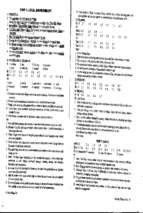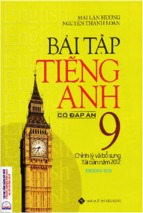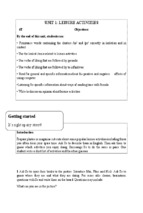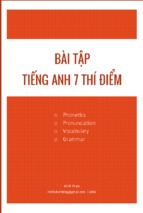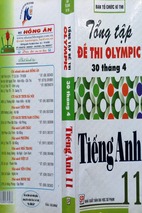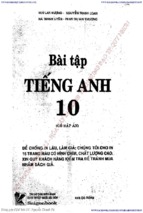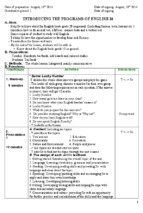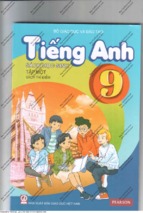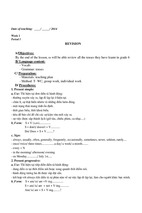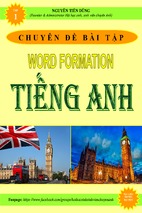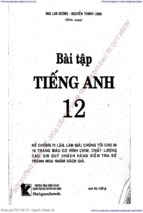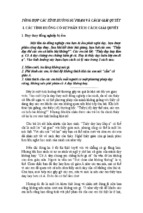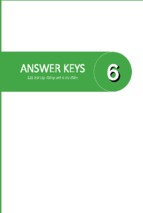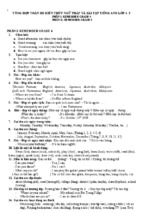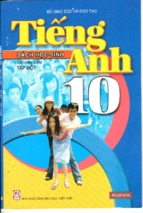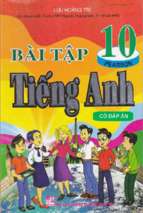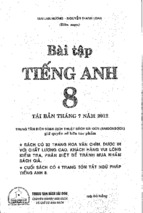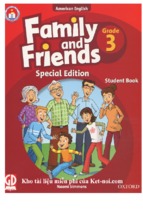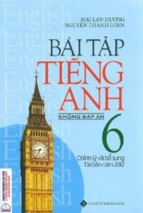CHUYÊN ĐỀ: TEACHING SKILLS TO DO
READING COMPREHENSION TESTS
Tác giả:Đỗ Thị Thu Minh
Giáo viên trường THPT Vĩnh Yên
Đối tượng học sinh: Lớp 12, Ôn thi ĐH – CĐ
Số tiết dự kiến: 10 tiết
1. Đối tượng bồi dưỡng : Học sinh lớp 12
2. Số tiết dạy dự kiến : 10
3. Hệ thống kiến thức :
Skill 1-Answer main idea questions correctly.
Skill 2. Answer stated detail questions correctly.
Skill 3 :Find “unstated” details
Skill 4. Find pronoun referents.
Skill 5. Answer implied detail questions correctly.
Skill 6. Find definitions from structural clues.
Skill 7. Use context to determine meanings of difficult words.
Skill 8. Use context to determine meanings of simple words.
Skill 9. Determine the tone, purpose, or course
TEACHING SKILLS TO DO READING COMPREHENSION
TESTS:
Each reading passage is often followed by 10 questions of reading
comprehension and vocabulary. Topics of the reading passage are varied,
but they are often informational subjects such as history, literature, art,
architecture, geology, geography, and astronomy. Time is definitely a
factor in the Reading Comprehension.
Some students, especially average students, note that they are unable to
finish all the questions in this section. Others cannot understand what the
passage is about, so they do without intention and don’t know surely if
their answer is true. Therefore, they need to make the most efficient use
of their time in this section to get the highest score. The following
method is the best way of attacking a reading passage to get the most
questions correct in a limited amount of time.
STRAGIES FOR THE READING COMPREHENSION
QUESTIONS
1. Skim the reading passage to determine the main idea and the overall
organizations of ideas in the passage. You do not need to understand
every detail in each passage to answer the questions correctly. It is
therefore a waste of time to read the passage with the intent of
understanding every single detail before you try to answer the
questions.
2. Look ahead at the questions to determine what types of questions you
must answer. Each type of question is answered in a different way.
3. Find the section of the passage that deals with each question. The
question – type tells you exactly where to look in the passage to find
correct answers.
- For main ideas questions, look at the first line of each paragraph.
- For directly and indirectly answered detail questions, choose a key
word in the question, and skim for that key word (or a related idea)
in order in the passage.
- For vocabulary questions, the questions will tell you where the
word is located in the passage.
- For overall review questions, the answers are found anywhere in
the passage.
4. Read the part of the passage that contains the answers carefully. The
answer will probably be in the same sentence (or one sentence before
or after) the key word or idea.
5. Choose the best answer to each question from the four answer choices
listed in the textbook. The best answer can be chosen according to
what is given in the appropriate section of the passage, eliminate
definitely wrong answers, and mark the best guess on the answer
sheet.
The following skills will help students to implement these strategies in
the Reading passage of the test.
A. QUESTIONS ABOUT THE IDEAS OF THE PASSAGE___________________
It is very common for reading passages of the test to have questions about
the overall ideas in the passage. The most common type of question asks
about the main idea, topic, title, or subject.
Skill 1. Answer main idea questions correctly.
Students may be asked to identify the topic, subject, title, primary idea, or
main idea. These questions are all really asking what primary point that
the author is trying to get across in the passage, and it is not difficult to
find the main idea by studying the topic sentence, which is most probably
found at the beginning of a paragraph.
If the passage consists of only one paragraph, students should study the
beginning of that paragraph to determine the main idea. If a passage
consists of more than one paragraph, students study the beginning to
determine the main idea.
Example 1. In the Second Semester Test, Grade 12, year 2010-2011,
Code AV 121, the Reading comprehension is that:
The Asian Beach Games is a multi – sport event held every two years
among athletes representing countries from Asia. The games are
regulated by the Olympic Council of Asia. The first Games were held in
2008 in Bali, Indonesia.
This Games will be composed of sports with strong television appeal such
as windsurfing, kite boarding, swimming, beach volleyball, beach
handball, beach soccer, and dragon boat racing.
The Asian Indoor Games is a multi – sport event held every two years
among athletes representing countries from Asia. The Games are
regulated by the Olympic Council of Asia. The first Games were held in
Bangkok, Thailand.
This Games will be composed by sports with TV broadcasting potential
and not included in the Asian Games and Winter Asia Games Programs
and are not Olympic sports. The sports program will comprise from six to
eight exciting sports with strong television appeal, including electronic
sports, extreme sports, aerobics, acrobatics, indoor athletics, dance sports,
inline hockey, fin swimming, and 25 meters short course swimming.
Question 27. The passage is about …………………………
A. The Asian Beach Games and the Asian Indoor Games.
B. The Olympic Council of Asia.
C. The Asian Games and Winter Asian Games Programs.
D. The Asian Indoor Games and Winter Asian Games Programs.
In the above given passage, there are four paragraphs. Students should be
sure to read the first sentence of each paragraph to determine the subject,
title, or main idea. In Example 1, the first sentence of the first paragraph
of this passage discusses the Asian Beach Games, and the second
paragraph begins with “this Games”, which means that it is about the
Asian Beach Games. The first sentence of the third paragraph tells of the
Asian Indoor Games, about which the fourth paragraph tells, also
beginning with “this Games”. So the whole passage discusses the two
kinds of games: the Asian Beach Games and the Asian Indoor Games.
Therefore, the best choice is answer A.
The following chart outlines the key information that students should
remember about main idea questions:
MAIN IDEA QUESTIONS
HOW
TO What is the topic of the passage?
IDENTIFY THE What is the subject of the passage?
QUESTIONS
What is the main idea of the passage?
What is the author’s main point in the passage?
With what is the author primarily concerned?
Which of the following would be the best title?
WHERE
TO The answer to this type of question can generally be
FIND
THE determined by looking at the first sentence of each
ANSWER
paragraph.
HOW TO
1. Read the first line of each paragraph.
ANSWER THE
2. Look for a common theme or idea in the first
QUESTION
lines.
3. Pass your eyes quickly over the rest of the
passage to check that you really have found the
topic sentence(s).
4. Eliminate any definitely wrong answers and
choose the best answer from the remaining
choices.
B. DIRECTLY ANSWERED QUESTIONS________________________________
Skill 2. Answer stated detail questions correctly.
A stated detail question asks about one piece of information in the
passage rather than the passage as a whole. The answers to these
questions are generally given in order in the passage, and the correct
answer is often a restatement of what is given in the passage. This means
that the correct answer often expresses the same idea as what is written in
the passage, but the words are not exactly the same.
Example 2: In English 10, page 45 and 46, Unit 4 “Special Education”,
Part Reading, the second paragraph:
At first, there was a lot of opposition from the parents of the disabled
children. They used to believe that their children could not learn anything
at all. In the first week, only five children attended the class. Gradually
more children arrived. Their parents realized that the young teacher was
making great efforts to help their poor kids.
Task 2:
Question 2: At first the parents were ____________ the idea of sending
their children to the special class.
A. interested in
B. opposed to
C. satisfied with D.
worried about
Since in the first sentence of the paragraph, there is the noun
“opposition”, we can see from the four answers the verb “opposed” in
the answer B, they are in a family. So the answer B is the best one.
The following chart outlines the key information that students should
remember about stated detail questions:
STATED DETAIL QUESTIONS
HOW TO
According to the passage, …
IDENTIFY THE It is stated in the passage …
QUESTION
The passage indicates that …
The author mentions that …
Which of the following is true …?
WHERE
TO The answers to these questions are found in order in
FIND
THE the passage
ANSWER
HOW
TO
1. Choose a key word in the question.
ANSWER THE
2. Skim in the appropriate part of the passage for
QUESTION
the key word or idea.
3. Read the sentence that contains the key word
or idea carefully.
4. Look for the answer that restates an idea in the
passage.
5. Eliminate the definitely wrong answers and
choose the best answer from the remaining
choices.
Skill 3. Find “unstated” details.
Students will sometimes be asked to find an answer that is not stated or
not mentioned or not true in the passage. This type of question really
means that three of the answers are stated, mentioned, or true in the
passage, while one answer is not. The actual job is to find the three
correct answers and then choose the letter of the one remaining answer.
The teacher asks students to notice that there are two kinds of answers to
this type of question:
1) There are three true answers and one answer that is not discussed
in the passage.
2) There are three true answers and one that is false according to the
passage.
Example 3: In English 12, page 163 and 164, Unit 15 “Woman in
Society”, Part Reading, the last paragraph:
Today, although their status varies in different countries, women in most
parts of the world have gained significant legal rights. The most
important of these are: the right to have equal work opportunities and pay
to men, the right to vote, and the right to formal education.
Task 2:
Question 5: Which of the following is NOT mentioned in the last
paragraph as one of women’s legal rights today?
A. the right to hold property
B. the right to equal pay
C. equal employment opportunity rights
D. the right to vote
The question asks for the one answer that is not mentioned, so three of the
answers are listed in the passage and one is not. Since the right to equal
pay, equal employment opportunity rights, the right to vote, are listed in
the passage, answers B, C, and D are incorrect. However, the right to
hold property is not listed in the passage, so answer D is the best answer
to this question.
The following chart outlines the key information that students should
remember about “unstated” detail questions:
“UNSTATED” DETAIL QUESTIONS
HOW
TO Which of the following is not stated …?
IDENTIFY THE Which of the following is not mentioned …?
QUESTION
Which of the following is not discussed …?
All of the following are true except …?
WHERE
TO The answers to these questions are found in order in
FIND
THE the passage.
ANSWER
HOW
TO
1. Choose a key word in the question.
ANSWER THE
2. Scan in the appropriate place in the passage for
QUESTION
the key word (or related idea).
3. Read the sentence that contains the key word
or idea carefully.
4. Look for answers that are definitely true
according to the passage. Eliminate those
answers.
5. Choose the answer that is not true or not
discussed in the passage.
Skill 4. Find pronoun referents.
In the Reading comprehension of the test, you will sometimes be asked to
determine which noun a pronoun refers to. In this type of question it is
important to understand that a noun is generally used first in a passage,
and the pronoun that refers to it comes after. Whenever you are asked
which noun a pronoun refers to, you should look before the pronoun to
find the noun.
Example 4: In the Second Semester Test, Grade 12, year 2011-2012,
Code AV 101, the Reading comprehension is that:
Arctic Ice May Disappear in a Decade
A new report on global warming predicts the frozen Arctic Ocean will
soon be like a normal sea in the summers. There are shocking changes
happening in the polar environment and its fragile eco-systems. For
millions of years, the sea around the North Pole has been frozen all year
round. Recent research from the World Wildlife Fund (WWF) and the
Catlin Atlantic Survey show things are changing fast. They predict that
within a decade, the Arctic will be largely ice-free in the summer. They
base their prediction on the rate at which the sea ice is currently thinning.
The lead researcher, professor Peter Wadhams said, “The area is now
more likely to become open water each summer, bringing forward the
potential date when the summer sea ice will be completely gone.”
An ice-free Arctic will have consequences for the whole world’s weather
patterns. The Arctic sea ice is a key part of the Earth’s climate system.
Experts call it Earth’s “refrigerator”. They said that as it disappears, the
world will become a lot warmer. Scientists are still unclear exactly what
changes there will be to our weather. Forecasters predict an increase in all
kinds of disasters and extreme weather events. These include massive
flooding, much more dangerous hurricanes and the spread of the world’s
deserts. These new findings provide an urgent call for world leaders to
act. The timing of the WWF report is a reminder to those attending the
UN climate summit in Copenhagen in December. Rich countries will face
pressure to agree to reduce their carbon emissions by40 per cent by 2020.
Question: 33. What does the word “it” in paragraph 2 refer to?
A. the Arctic sea ice
B. climate system
C. refrigerator
D. the Earth
To answer this question, students should look before the pronoun it for
singular nouns that pronoun could refer to. An ice sea Arctic, the Arctic
sea ice, the Earth’s climate system come before the pronoun, so they are
possible answers. Then students should try the three possible answers in
the sentence in place of the pronoun. From the following sentence
students should notice that as it disappears, the world will become a lot
warmer , so the best answer to this question is answer A.
The following chart outlines the key information that students should
remember about pronoun referents:
HOW TO
IDENTIFY THE
QUESTION
WHERE TO
FIND THE
ANSWER
HOW TO
ANSWER THE
QUESTION
PRONOUN REFERENTS
The pronoun “…” in line X refers to which of the
following?
The line where the pronoun is located is generally
given in the question. The noun that the pronoun
refers to is generally found before the pronoun.
1. Find the pronoun in the passage. (The line
where the pronoun can be found is generally
stated in the question.)
2. Look for nouns that come before the pronoun.
3. Read the part of the passage before the pronoun
carefully.
4. Eliminate any definitely wrong answers and
choose the best answer from the remaining
choices.
C. INDIRECTLY ANSWER QUESTIONS________________________________
Some questions of the Reading Comprehension section of the test will
require answers that are not directly stated in the passage. To answer
these questions correctly, you will have to draw conclusions from
information that is given in the passage. Two common types of indirectly
answer questions are:
(1) implied detail questions and
(2) transition questions.
Skill 5. Answer implied detail questions correctly.
You will sometimes be asked to answer a question by drawing a
conclusion from a specific detail are details in the passage. Questions of
this type contain the words implied, inferred, likely, or probably to let
you know that the answer to the question is not directly stated. In this
type of question it is important to understand that you do not have to
“pull the answer out of thin air.” Instead, some information will be given
in the passage, and you will draw a conclusion from that information.
Example 5: In English 10, page 45 and 46, Unit 4 “Special Education”,
Part Reading, the second paragraph is :
At first, there was a lot of opposition from the parents of the disabled
children. They used to believe that their children could not learn anything
at all. In the first week, only five children attended the class. Gradually
more children arrived. Their parents realized that the young teacher was
making great efforts to help their poor kids.
Task 2:
Question 3: It can be inferred from the second paragraph of the reading
passage that there has been ______________________.
A. a change in the parents’ attitude towards the class
B. a lot of protest from the parents against the class
C. a feeling of doubt in the teacher’s ability
D. a belief in the parents’ opposition
To answer this question, students should refer to the part of the passage
where it states that in the past the parents had a lot of opposition, but now
they don’t, so the answer B is incorrect. It also says that their parents
realized that the young teacher was making great efforts to help their
poor kids, which means the parents don’t have the feeling of doubt in the
teacher’s ability, then the answer C is incorrect, too. The sentence
“Gradually more children arrived” shows that the parents have a change
in the parents’ attitude towards the class, so the answer D can’t be
correct and the best answer is A.
The following chart outlines the key information that students should
remember about implied detail questions:
HOW
TO
IDENTIFY THE
QUESTION
WHERE
FIND
ANSWER
HOW
ANSWER
QUESTION
TO
THE
TO
THE
IMPLIED DETAIL QUESTION
It is implied in the passage that …
It can be inferred from the passage that …
It is most likely that …
What probably happened …?
The answers to these questions are found in order in
the passage.
1. Choose a key word in the passage.
2. Scan the passage for the key word (or a related
idea).
3. Carefully read the sentence that contains the
key word.
4. Look for a answer that could be true, according
to that sentence.
D. VOCABULARY QUESTIONS_______________________________________
In the Reading Comprehension section of the test, there will be a number
of vocabulary questions. To answer this type of question, it is of course
useful if you know the meaning of the word that the test is testing.
However, it is not always necessary for you to know the meaning of the
word; often there are skills that you can use to help you find the correct
answer to the question:
(1) finding definitions from structural clues;
(2) determining meanings from the word parts, and
(3) using context clues to determine meanings.
Skill 6. Find definitions from structural clues.
When you are asked to determine the meaning of a word in the Reading
Comprehension section of the test, it is possible
(1) that the passage provides information about the meaning of the
word, and
(2) that there are structural clues to tell you that the definition of a
word is included in the passage.
Example 6:
In law, a nuisance is an act that has no legal justification and which
interferes with the safety or comfort of other people. Public nuisances,
those which are injurious to the community, may be prosecuted as crimes.
Question: A nuisance is _______________.
A. a protective law
B. an injurious act
C. a legal justification
D. a safety precaution
We should choose answer B because a “nuisance” is an act which
interferes with the safety of others, that is, an injurious act.
The following chart outlines the key information that students should
remember about structural clues to help you understand unknown
vocabulary words:
HOW
TO
IDENTIFY THE
QUESTION
TYPES
OF
CLUES
WHERE
FIND
ANSWER
HOW
TO
THE
TO
STRUCTURAL CLUES
What is …?
What is the meaning of …?
What is true about …?
Punctuation: comma, parentheses, dashes
Restatement: or, that is, in other words, i.e.
Examples:
such as, for example, e.g.
Information to help you determine what something
means will generally be found after the punctuation
clue, the restatement clue, or the example clue.
1. Find the word in the passage.
ANSWER THE
QUESTION
2. Locate any structural clues.
3. Read the part of the passage after the structural
clue carefully.
4. Eliminate any definitely wrong answer and
choose the best answer from the remaining
choices.
Skill 7. Use context to determine meanings of difficult words.
On the test you will sometimes be asked to determine the meanings of the
difficult words, a word that you are not expected to know. In this case,
the passage will give you a clear indication of what the word means.
Example 7: In the Second Semester Test, Grade 12, year 2011-2012,
Code AV 101, the Reading comprehension is as follows:
Arctic Ice May Disappear in a Decade
A new report on global warming predicts the frozen Arctic Ocean will
soon be like a normal sea in the summers. There are shocking changes
happening in the polar environment and its fragile eco-systems. For
millions of years, the sea around the North Pole has been frozen all year
round. Recent research from the World Wildlife Fund (WWF) and the
Catlin Atlantic Survey show things are changing fast. They predict that
within a decade, the Arctic will be largely ice-free in the summer. They
base their prediction on the rate at which the sea ice is currently thinning.
The lead researcher, professor Peter Wadhams said, “The area is now
more likely to become open water each summer, bringing forward the
potential date when the summer sea ice will be completely gone.”
An ice-free Arctic will have consequences for the whole world’s weather
patterns. The Arctic sea ice is a key part of the Earth’s climate system.
Experts call it Earth’s “refrigerator”. They said that as it disappears, the
world will become a lot warmer. Scientists are still unclear exactly what
changes there will be to our weather. Forecasters predict an increase in all
kinds of disasters and extreme weather events. These include massive
flooding, much more dangerous hurricanes and the spread of the world’s
deserts. These new findings provide an urgent call for world leaders to
act. The timing of the WWF report is a reminder to those attending the
UN climate summit in Copenhagen in December. Rich countries will face
pressure to agree to reduce their carbon emissions by40 per cent by 2020.
Question 32: The word “fragile” in the passage mostly means
…………………..
A. easily broken B. easily damaged C. physically weak __________D. extremely
complicated
To answer this question, students should look at the sentence that
contains the word fragile. It comes before the word eco-system, which
means that it is an adjective of the latter word. So it cannot be easily
broken, physically weak or extremely complicated, then answers A, C,
and D are incorrect. As a result, answer B is the best answer to this
question.
The following chart outlines the key information that students should
remember about vocabulary questions containing difficult words:
VOCABULARY QUESTIONS CONTAINING DIFFICULT WORDS
HOW
TO “What is the meaning …?”
IDENTIFY THE “Which of the following is closest in meaning to …?”
QUESTION
The word is a difficult word, one that you probably
do not know.
WHERE
TO The question usually tells you in which line of the
FIND
THE passage the word can be found.
ANSWER
HOW
TO
1. Find the word in the passage.
ANSWER THE
2. Read the sentence that contains the word
QUESTION
carefully.
3. Look for context clues to help you understand
the meaning.
4. Choose the answer that the context indicates.
Skill 8. Use context to determine meanings of simple words.
You will sometimes be asked to determine the meaning of a simple word,
a word that you see often in everyday English. In this type of question,
you should not give the normal, everyday meaning of the word; instead,
the test wants to know the meaning of the word in this situation.
Example 8: A line from the passage:
….. He put his answer this way ….
Question: The word “put” is closest in meaning to which of the
following?
A. placed
B. set
C. expressed
D. handed
In this type of question, students should understand that put is a normal,
everyday word, and they are not being asked to give the regular meaning
of a normal, everyday word. Because the primary meaning of to put is to
place, answer A is not the correct answer. To answer this type of question
students must see which of the answers best fits into the sentence in the
passage. We cannot place an answer or set an answer or hand an answer,
but we can express an answer, so answer C is the best answer to this
question.
The following chart outlines the key information that students should
remember about vocabulary questions containing simple words.
VOCABULARY QUESTIONS CONTAINING SIMPLE WORDS
HOW
TO “What is the meaning …?”
IDENTIFY THE “Which of the following is closest in meaning to …?”
QUESTION
The word is a simple word, one that you see often in
everyday English.
WHERE
TO The question usually tells you in which line of the
FIND
THE passage the word can be found.
ANSWER
HOW
TO
1. Find the word in the passage.
ANSWER THE
2. Read the sentence that contains the word
QUESTION
carefully.
3. Look for context clues to help you understand
the meaning.
4. Choose the answer that the context indicates.
E. OVERALL REVIEW QUESTIONS____________________________________
Often in the Reading Comprehension section of the test, the last question
(or two) for a particular reading passage is an overall question, one that
asks about the passage as a whole rather than one small detail. The
overall review questions are generally not main idea questions; instead
they ask about some other aspect of the passage as a whole. The most
common types of overall review questions are
(1) questions that ask where in the passage something is found;
(2) questions about the tones of the passage;
(3) questions about the author’s purpose in writing the passage, or
(4) questions about which course the passage might be a part of.
Skill 9. Determine the tone, purpose, or course.
Other types of overall review questions occur occasionally in the Reading
Comprehension section of the test. Possible questions of this type are
those that ask about:
(1) the tone of the passage;
(2) the author’s purpose in writing the passage, and
A question about the tone is asking if the author is showing any emotion
in his or her writing. The majority of the passages on the test are factual
passages presented without any emotion; the tone of this type of passage
could be simply informational, explanatory, or factual. Sometimes on the
test, however, the author shows some emotion, and you must be able to
recognize that emotion to answer a question about tone correctly. If the
author is being funny, then the tone might be humorous; if the author is
making fun of something, the tone might be sarcastic; if the author feels
strongly that something is right or wrong, the tone might be impassioned.
A question about purpose is asking what the author is trying to do in the
passage. You can draw a conclusion about the author’s purpose by
referring to the main idea and the organization of details in the passage.
For example, if the main idea is that George Washington’s early life
greatly influenced his later career and if the details give a history of his
early life, the author’s purpose could be to show how George
Washington’s early life influenced his later career. However, the answer
to a purpose question is often considerably more general than the main
idea. A more general author’s purpose for the main idea about George
Washington would be to demonstrate the influence of early experiences
on later life (without any mention of George Washington).
Example 9: In English 10, page 45 and 46, Unit 4 “Special Education”,
Part Reading:
A TEACHER IN A SPECIAL CLASS
Like other teachers, Pham Thu Thuy enjoys her teaching job. However,
her class is different from other classes. The twenty-five children, who
are learning how to read and write in her class, are disabled. Some are
deaf, some dumb and others mentally retarded. Most of the children come
from large and poor families, which prevents them from having proper
schooling.
At first, there was a lot of opposition from the parents of the disabled
children. They used to believe that their children could not learn anything
at all. In the first week, only five children attended the class. Gradually
more children arrived. Their parents realized that the young teacher was
making great efforts to help their poor kids.
Watching Thuy taking a class, one can see how time-consuming the work
is. During a maths lesson, she raised both arms and opened up her fingers
one by one until all ten stood up. She then closed the fingers one by one.
She continued the demonstration until the children realized they had just
learned how to add and subtract. The children have every reason to be
proud of their efforts. They know a new world is opening up for them.
Question 5: The writer’s attitude towards Thuy’s work in the passage can
be described as_____________.
A. humorous
B. angry
C. suspicious
D. admiring
The question asks about the tone (writer’s attitude) of the passage. To
determine the tone of a passage, students should look for any indications
of emotion on the part of the writer. In this passage, the writer shows the
great efforts the teacher has made to help the poor kids who later see a
new horizon opening up for them. Therefore, the best answer to this
question is answer D. There is nothing in the passage to indicate any
humor A, anger B, or suspicion C on the part of the writer.
The following chart outlines the key information that students should
remember about tone, purpose, or course questions:
HOW
IDENTIRY
QUESTION
WHERE
FIND
ANSWER
TO
THE
TO
THE
TONE, PURPOSE, OR COURSE
Tone:
What is the tone of the passage?
Purpose: What is the author’s purpose in this
passage?
Tone:
There will be clues throughout the passage
that the
author is showing some emotion rather than
just
presenting facts.
Purpose: Draw a conclusion about the purpose form
the
main idea and supporting details.
HOW
TO Tone:
1. Skim the passage looking for clues that
ANSWER THE the
QUESTION
author is showing some emotion .
2. Choose the answer that identifies the
emotion.
Purpose: 1. Study the main idea in the topic
sentence and
the details used to support the main idea.
2. Draw a conclusion about the purpose.
B. READING COMPREHENSION EXERCISES
Reading
Exercise 1:
Read the two passages and choose the best answer for each of the
questions that follow.
A.
Before ballpoint pens or fountain pens, pens were made from goose
faethers. These goose feathers, called quills, were sharpened and dipped
into inkwells, where they absorbed enough ink to write a few words. It
wass necessary to keep an inkwell very close by, as frequent dipping was
necessary.
These quill pens were one of the earliest products
“designed”specifically for left and right- handed people. Fathers from the
left wing of the goose worked best for the right- handers because of the
way that the feathers arched. Feathers from the right wing were preferred
by left- handers.
1. Which of the following is the best title for this passage?
a.Early Ballpoint and Fountain pens
b. Quill Pens for Lefties and Righties
c. Where quill Pens Came from.
d. Various Users for goose Feathers.
2. The passage indicates that a quill pen could hold enough ink to
write………..
a. one or two pages
b. for about one hour
c. a couple of words
d. numerous sentences
3. Look at the word designed in paragraph two. It could be best the
replaced by………….
a. defined
b. devised
c. deformed
d.
deferred
4. Which of the following is NOT true about quill pens, according to the
passage?
a. Left- handers were unable to use quill pens.
b. Left- handers people generally preferred quills from the right
wing.
c. Right- handers could use quill pens
d. Right- handed – people generally preferred quills from the left
wing.
5. It can be inferred from the passage that quill pens………..
a. are still used regularlytoday
b. are referred over ballpoint
pens
c. are the best pens for the left- handers.
d.are not longer
used much
B.
When you can’t touch the car door handle or sit on the seat because
they are so hot, you are meeting solar energy. We can use this heaat from
the sun to keep us warm and give us electricity.
We know that we will someday run out of the fossil fuels, such as
oil, gas and coal. And we are now spending lots of money to learn how to
put nuclear energy to work for us. But we knoe that the radioactive
wastes that result from using nuclear energy can be very dangerous.
We need a supply of energy that will not pollute our air or water,
that will not cost too much and thatwill not run out. One of the sources
we are considering is the sun. Enough sunshine falls on the United States
in one minute to give the whole country all the energy, we’ll be able to
make as much electricity as we need. And it wouldn’t make smog in our
air or poison our water.
We could collect the sun’s heat in big sun farms. A good place for
a sun farm is on the desert, where the sky is clear and there is plenty of
sunshine and only a little rain. People could set up acres of glass mirrors
to focus the sun’s rays on a special surface that would become very hot.
Or they could put out acres and acres of glass- covered collectors called
solar energy traps to gather the sun’s heat. The heat would melt a special
metal;this melted metal would below to a largetank of melted salt; the
melted salt would then take the heat from the metal and hold it.
This stored heat could then be used like the heat we get rom
burning fossil fuels. It would make steam and turn generators to make
electricity. There would even be enough heat to make steam during the
night and on cloudy days.
The trouble is that collecting the sun’s heat in these ways is
expensive right now. We need to find out how to make these methods
cost les before we can have big sun farms on our deserts.
Scientists are trying to make a solar energy collector that they hope
will be cheap enough for anybody to put on a house- either on the roof or
in the wall. The inventors are making these solar collectors in kits for
people who want to do- it themselves.
6. What is the subject of this selection?
a.Kinetic energy
b. nuclear energy
c. Mechanical enegy
d. Solar energy
7. According to this article,……..
a. the sun is a good source of energy
b. smog does not
pollute the air
c. nuclear energy is safe and clean
d. many people use
solar energy.
8. The best place for a sun farm is the………
a. desert
b. seashore
c. moutains
d. forest
9. Scientists……
a. have final found a safe way to use nuclear energy.
b. Know that fossil fuels willlast forver
c. Are still experimenting with energy from the sun
d. Have found the cheap way to collect the sun’s heat
10. The writer feels that nuclear energy……
a. will soon run out
b. is cheap c. is clean
d.
can be harmful
Exercise 2:
Read the two passages and choose the best answer for each of the
questions that follow.
A.
From the start of his career as a writer, Mark Twain was fascinated
with inventions. As a result, he chose to spend much of his available
income on various types of inventions, generally without much success.
In fact, he lost most of the money he invested. By 1887, the 49- year- old
author had invested most of his money in one project, the Paige
typesetting machine.
Twain expected the Paige machine to be completed in 1989.
Unfortunately, the machine was never completely finished, and by the
early 1980s, Twain kneww he was in serious financial situation. He
worked hard to take care of his problems by producing a number of books
is a row he wrote A Connecticut Yankee in King Arthur’s Court (1892),
- Xem thêm -

